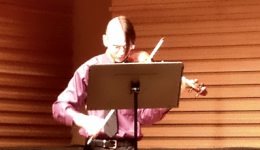Trevor M


Instruments: Violin, Viola
Styles: Classical


Trevor M

Instruments: Violin, Viola
Styles:
Classical
Where I Teach:
In Your Home
Ages Taught: 6-80
ABOUT
Degrees / Training / Special Info:
A.A., Hillsborough Community College, Music
B.A., University of South Florida, Music
Florida Music K-12 SOE
Overview:
First of all, thank you for taking the time to look at my profile! I know you have many choices when it comes to string instructors in the area, so I appreciate your time to find out a little about me. After earning an AA in Music from HCC in 2011, I transferred to the University of South Florida, where I studied music education and orchestral conducting. I graduated from USF with my BA in Music Studies in 2013. I have played as a soloist and in several string quartets around the Tampa Bay area since 2008. I am also a published composer, and some of the pieces I have written have been specifically for my students to be performed at recitals and other events.
EXPERIENCE
Over the course of the past nine years I have taught in private music schools, public schools, and students' homes. My lessons are structured around what the student wants. For example, I have taught many students in middle and high school who wanted to prepare for competitions or college auditions. I have also taught many young children, who simply enjoy the sound of a stringed instrument and want to make that sound themselves! I have even taught adults in their fifties and sixties who want to pick up their instrument after a long absence. I take great pride in being a teacher, and few things bring me more joy than seeing a student succeed or say "Oh, now I get it!" in a music lesson. Whether I'm preparing a student for a college audition, a recital, or even just to play "Mary Had a Little Lamb" for mom and dad, every student is important to me, and every lesson is tailored to each individual students' needs.
METHODS USED
For beginner students, I start with Hal Leonard's "Essential Elements for Strings" Book 1. This book is not only great for learning the fundamentals of the instrument (such as the names of the parts of the instrument, how to hold the instrument, etc.) but it also the best book I have found to teach beginning students how to read music on the violin and viola. For more advanced students, I like to stick with a formula of three things: scales (two-three octaves), an etude (a piece used to focus on a specific technique), and solo repertoire. All students will also learn proper warm-up and cool-down methods, such as stretching and breathing techniques.
LESSON STYLE
It is extremely important to me that every student benefits from his or her own personally tailored lesson. This means that there is no "cut and paste" lesson plan to use with each student. Once I get to know the student, I will be able to judge their level of playing ability, their ability to read music, how good their posture is, how good their hand position is, etc. It is also important to me to get to know the student's personality, so that when teaching, I can help make the student feel as comfortable as possible during the lesson. Then, we must determine what the student wants to learn, and figure out the best way to about learning whatever that may be. Finally, we will determine the student's short-term and long-term goals and keep track of these in a weekly planner or notebook.
PHOTOS & VIDEOS
Leave a Review
Leave a Review
RATING & REVIEW

